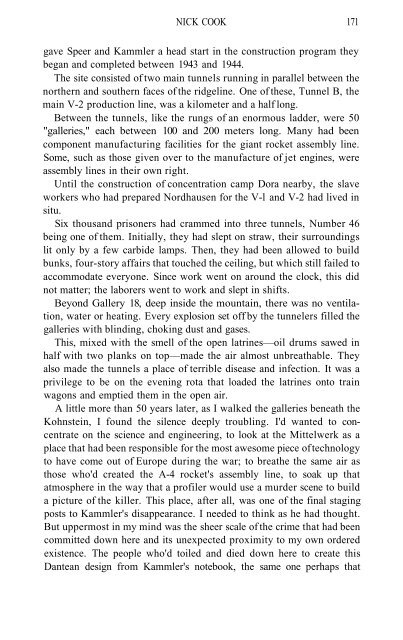ScienceDirect - Technol Rep Tohoku Univ ... - Garryck Osborne
ScienceDirect - Technol Rep Tohoku Univ ... - Garryck Osborne
ScienceDirect - Technol Rep Tohoku Univ ... - Garryck Osborne
You also want an ePaper? Increase the reach of your titles
YUMPU automatically turns print PDFs into web optimized ePapers that Google loves.
NICK COOK 171<br />
gave Speer and Kammler a head start in the construction program they<br />
began and completed between 1943 and 1944.<br />
The site consisted of two main tunnels running in parallel between the<br />
northern and southern faces of the ridgeline. One of these, Tunnel B, the<br />
main V-2 production line, was a kilometer and a half long.<br />
Between the tunnels, like the rungs of an enormous ladder, were 50<br />
"galleries," each between 100 and 200 meters long. Many had been<br />
component manufacturing facilities for the giant rocket assembly line.<br />
Some, such as those given over to the manufacture of jet engines, were<br />
assembly lines in their own right.<br />
Until the construction of concentration camp Dora nearby, the slave<br />
workers who had prepared Nordhausen for the V-l and V-2 had lived in<br />
situ.<br />
Six thousand prisoners had crammed into three tunnels, Number 46<br />
being one of them. Initially, they had slept on straw, their surroundings<br />
lit only by a few carbide lamps. Then, they had been allowed to build<br />
bunks, four-story affairs that touched the ceiling, but which still failed to<br />
accommodate everyone. Since work went on around the clock, this did<br />
not matter; the laborers went to work and slept in shifts.<br />
Beyond Gallery 18, deep inside the mountain, there was no ventilation,<br />
water or heating. Every explosion set off by the tunnelers filled the<br />
galleries with blinding, choking dust and gases.<br />
This, mixed with the smell of the open latrines—oil drums sawed in<br />
half with two planks on top—made the air almost unbreathable. They<br />
also made the tunnels a place of terrible disease and infection. It was a<br />
privilege to be on the evening rota that loaded the latrines onto train<br />
wagons and emptied them in the open air.<br />
A little more than 50 years later, as I walked the galleries beneath the<br />
Kohnstein, I found the silence deeply troubling. I'd wanted to concentrate<br />
on the science and engineering, to look at the Mittelwerk as a<br />
place that had been responsible for the most awesome piece of technology<br />
to have come out of Europe during the war; to breathe the same air as<br />
those who'd created the A-4 rocket's assembly line, to soak up that<br />
atmosphere in the way that a profiler would use a murder scene to build<br />
a picture of the killer. This place, after all, was one of the final staging<br />
posts to Kammler's disappearance. I needed to think as he had thought.<br />
But uppermost in my mind was the sheer scale of the crime that had been<br />
committed down here and its unexpected proximity to my own ordered<br />
existence. The people who'd toiled and died down here to create this<br />
Dantean design from Kammler's notebook, the same one perhaps that


